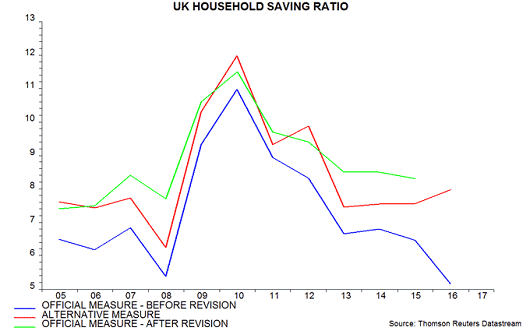
Janus Henderson: Data revisions confirm higher UK saving ratio
A reasonable provisional conclusion, pending the 2016-17 revised data, is that household finances are stronger than previously indicated, implying a smaller risk of a significant consumer spending downturn.
24.08.2017 | 16:26 Uhr
 A post in December argued that official figures were understating the UK household saving ratio, probably reflecting an underrecording of income. It presented an alternative saving ratio measure based on data on capital / financial asset accumulation and borrowing – this averaged 9.0% over 2010-15 versus 8.0% for the official measure.
A post in December argued that official figures were understating the UK household saving ratio, probably reflecting an underrecording of income. It presented an alternative saving ratio measure based on data on capital / financial asset accumulation and borrowing – this averaged 9.0% over 2010-15 versus 8.0% for the official measure.
The Office for National Statistics this week gave a preview of revisions to be included in the national accounts annual update on 29 September. The new figures show the saving ratio averaging 9.3% over 2010-15 – higher even than the alternative measure calculated here (although this may also change significantly when the full new data set is released). The upward revision mainly reflects a correction of previous underrecording of self-employment income.
The chart shows the official saving ratio measure before and after the revision, together with the alternative measure. Revised numbers are not yet available beyond 2015 – a key issue is whether the sharp decline in the old official series in 2016-17 will be mirrored in the new data. The alternative measure is currently shown as rising in 2016.

The upward revision to self-employment income may also have implications for the MPC’s assessment of labour cost pressures. Monthly average earnings numbers cover employees only. To the extent that higher-earners have switched to self-employed status, extracting income through corporate structures, the average earnings series may understate growth of compensation per person across the employed population as a whole. It should be possible to estimate the size of any such effect when the new data set is released.



Diesen Beitrag teilen: